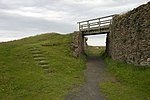Lindisfarne National Nature Reserve
LindisfarneNational nature reserves in EnglandNature reserves in NorthumberlandNorthumberland coastRamsar sites in England ... and 1 more
Sites of Special Scientific Interest in Northumberland

Lindisfarne National Nature Reserve is a 3,541-hectare (8,750-acre) UK national nature reserve. It was founded to help safeguard the internationally important wintering bird populations, and six internationally important species of wildfowl and wading birds winter here. For the pale-bellied brent geese from Svalbard, this is their only regular wintering place in all of the United Kingdom. Pinkfooted and greylag geese, wigeons, grey plovers and bar-tailed godwits are the other visitors.
Excerpt from the Wikipedia article Lindisfarne National Nature Reserve (License: CC BY-SA 3.0, Authors, Images).Lindisfarne National Nature Reserve
Straight Lonnen,
Geographical coordinates (GPS) Address Nearby Places Show on map
Geographical coordinates (GPS)
| Latitude | Longitude |
|---|---|
| N 55.677 ° | E -1.795 ° |
Address
Straight Lonnen (Straight Loaning)
Straight Lonnen
TD15 2SF , Holy Island
England, United Kingdom
Open on Google Maps









